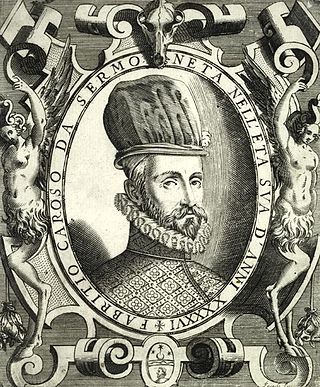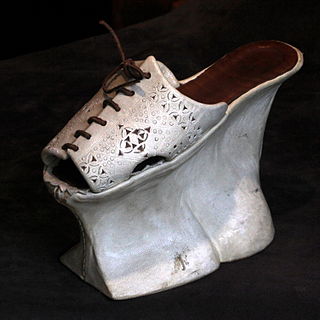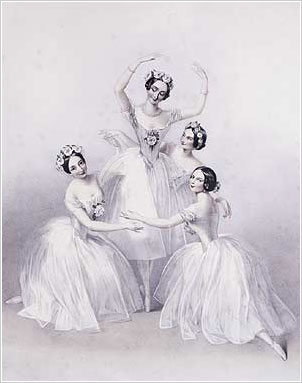Related Research Articles

Fabritio Caroso da Sermoneta was an Italian Renaissance dancing master and a composer or transcriber of dance music.

The galliard was a form of Renaissance dance and music popular all over Europe in the 16th century. It is mentioned in dance manuals from England, Portugal, France, Spain, Germany, and Italy.

The pavane is a slow processional dance common in Europe during the 16th century (Renaissance).

Renaissance dances belong to the broad group of historical dances, specifically those during the Renaissance period. During that period, there was a distinction between country dances and court dances. Court dances required the dancers to be trained and were often for display and entertainment, whereas country dances could be attempted by anyone. At Court, the formal entertainment would often be followed by many hours of country dances which all present could join in. Dances described as country dances such as Chiarantana or Chiaranzana remained popular over a long period – over two centuries in the case of this dance. A Renaissance dance can be likened to a ball.
Thoinot Arbeau is the anagrammatic pen name of French cleric Jehan Tabourot. Tabourot is most famous for his Orchésographie, a study of late sixteenth-century French Renaissance social dance. He was born in Dijon and died in Langres.

The volta is an anglicised name for a dance for couples that was popular during the later Renaissance period. This dance was associated with the galliard and done to the same kind of music. Its main figure consisted of a turn and lift in a sort of closed position, which could be done either to the right or to the left. It is also called La volta, Volta, Volte. Spelling variants include la volta and levolto; its name is la volte in French and la volta in Italian. It was considered at first to be risque and controversial. Although the dance was known at the court of Elizabeth I, the popular notion that Elizabeth and her favourite Lord Robert Dudley regularly performed the volta has been repudiated.

Historical dance is a term covering a wide variety of Western European-based dance types from the past as they are danced in the present. Today historical dances are danced as performance, for pleasure at themed balls or dance clubs, as historical reenactment, or for musicological or historical research.

The gavotte is a French dance, taking its name from a folk dance of the Gavot, the people of the Pays de Gap region of Dauphiné in the southeast of France, where the dance originated, according to one source. According to another reference, the word gavotte is a generic term for a variety of French folk dances, and most likely originated in Lower Brittany in the west, or possibly Provence in the southeast or the French Basque Country in the southwest of France. It is notated in 4
4 or 2
2 time and is usually of moderate tempo, though the folk dances also use meters such as 9
8 and 5
8.
Shakespearean dance refers to dancing in the time and plays of William Shakespeare and his contemporaries.

The passepied is a French court dance. Originating as a kind of Breton branle, it was adapted to courtly use in the 16th century and is found frequently in 18th-century French opera and ballet, particularly in pastoral scenes, and latterly also in baroque instrumental suites of dances. In English the passepied has been spelled "paspy" as well as "paspie" or "paspe", phonetic approximations of the French pronunciation.

A branle, also bransle, brangle, brawl(e), brall(e), braul(e), brando, bran, or brantle, is a type of French dance popular from the early 16th century to the present, danced by couples in either a line or a circle. The term also refers to the music and the characteristic step of the dance.

A chopine is a type of women's platform shoe that was popular in the 15th, 16th and 17th centuries. Chopines were originally used as a patten, clog, or overshoe to protect shoes and dresses from mud and street soil.

Pas de quatre is a French term used to identify a ballet dance for four people. Pas de quatre are usually plotless dances performed as divertissements within the context of a larger work. However, narrative pas de quatre and pas de quatre that stand alone are not unknown.

Cesare Negri was an Italian dancer and choreographer. He was nicknamed il Trombone, an ugly or jocular name for someone "who likes to blow his own horn". Born in Milan, he founded a dance academy there in 1554. He was an active court choreographer for the nobility in Milan. He wrote Le Grazie d'Amore, the first text on ballet theory to expound the principle of the five basic positions. It was republished in 1604 as Nuove Inventioni di Balli.
The tourdion is a lively dance, similar in nature to the galliard, and popular from the mid-15th to the late-16th centuries, first in the Burgundian court and then all over the French kingdom. The dance was accompanied frequently by the basse danse, due to their contrasting tempi, and were danced alongside the pavane and galliard, and the allemande and courante, also in pairs.

Italian folk dance has been an integral part of Italian culture for centuries. Dance has been a continuous thread in Italian life from Dante through the Renaissance, the advent of the tarantella in Southern Italy, and the modern revivals of folk music and dance.

Italian ballet is the training methods and aesthetic qualities seen in classical ballet in Italy. Ballet has a long history in Italy, and it is widely believed that the earliest predecessor of modern-day ballet originated in the Italian courts of the Renaissance. Two predominant training systems are used to teach Italian ballet today: the Cecchetti method, devised by Enrico Cecchetti, and that of the La Scala Theatre Ballet School.
So ben mi chi ha bon tempo or So ben mi, c'ha bon tempo is a balletto written by the Italian composer Orazio Vecchi. It appears in the 1590 publication Selva di varia ricreatione, for three to ten voices and is dedicated to Giacomo Seniori and Giovanni Fuccari. These works were written during Vecchi's tenure as canon at the Correggio Cathedral.
Julia Sutton was a musicologist and historian of early dance and music. She was professor at New England Conservatory of Music, teaching in the Music History and Musicology department, which she chaired for more than twenty years. She also taught in NEC's Performance of Early Music department, and directed the Collegium Terpsichore. Sutton was active in the founding of the Society of Dance History Scholars. She received her PhD from University of Rochester's Eastman School of Music in 1962.
References
- ↑ Julia Sutton, "Canary," in International Encyclopedia of Dance, edited by Selma Jeanne Cohen (New York: Oxford University Press, 1998), vol. 2, p. 50.
- ↑ Alan Brissenden, Shakespeare and the Dance (Atlantic Highlands, NJ: Humanities Press, 1981), pp. 38-39, 53.
- ↑ Sutton, "Canary," vol. 2, p. 50.
- ↑ Stanford, E. Thomas (1980). The New Grove Dictionary of Music and Musicians. London: Macmillan. ISBN 0-333-23111-2.
- ↑ Thoinot Arbeau, Orchesography, transl. Mary S. Evans, ed. Julia Sutton (New York: Dover, 1967), pp. 179-181.
- ↑ Sutton, "Canary," vol. 2, pp. 50-52.